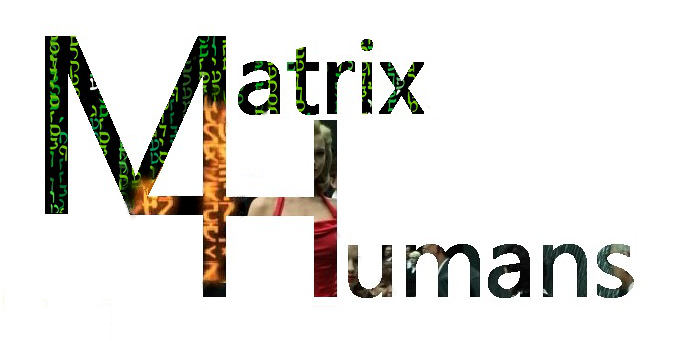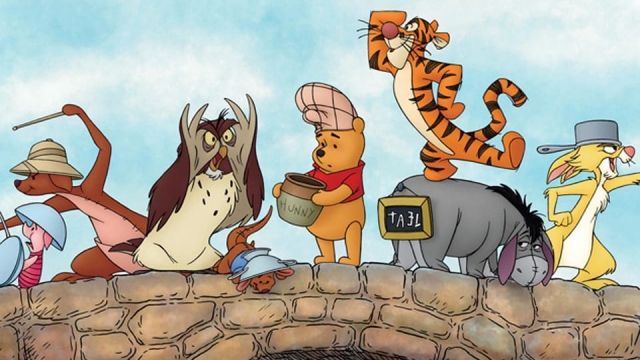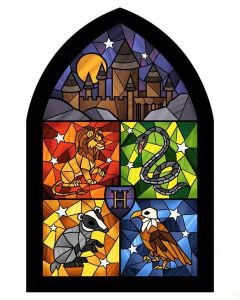 This post on Harry Potter is the fourth in The M-Files collection of articles. Our first three (The 7 Habits, 12-Step Program & Winnie the Pooh) focused on the sefirot, or emanations, of God. As discussed through our Matrix Knowledge Base, this is one of two templates that are the foundations of everything physical, emotional, intellectual and spiritual.
This post on Harry Potter is the fourth in The M-Files collection of articles. Our first three (The 7 Habits, 12-Step Program & Winnie the Pooh) focused on the sefirot, or emanations, of God. As discussed through our Matrix Knowledge Base, this is one of two templates that are the foundations of everything physical, emotional, intellectual and spiritual.
The other template is the concept of the Worlds of Existence, of which there are four (with a ‘hidden’ fifth world of pre-existence, which ties them all together).
First, we will review and expand on two concepts introduced in the introductory article on these worlds in our Knowledge Base.
What If You Had a Dream …
As we mentioned in our Knowledge Base, examples of this template of four are found throughout the Biblical narrative. One of the more direct ones is in Jacob’s dream in Genesis 28. Here, Jacob dreams of himself on earth, a ladder with angels ascending and descending, heaven above and beyond that stood the Lord.
To review, the four representations reveal the basic framework of existence. Starting at the ‘top’ these worlds and their basic descriptions are:
- A vision of the ‘immanent’ aspect of God. (That which we can relate to.) This the world of Atzilut, meaning ‘nearness’ (to the transcendent aspect of God ‘beyond’.) This is the world of “existence before creation.”
- At the top of the ladder is the heavenly realm. This is the world of Beriah, the highest level of creation – one consisting of what are called ‘forces’ or ‘powers.’
- The ladder of angels is the world of Yetzirah, meaning ‘formation.’ This is the ‘connecting’ world between physicality (below) and the heavenlies above.
- At the bottom of the ladder is Jacob in the physical world, called ‘Asiyah,’ which means ‘making.’
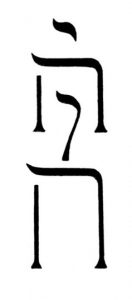 The Four-Letter Name
The Four-Letter Name
The above example of the template of four, along with all others, is grounded in what is called the “four-letter name of God.” This name is made up of the Hebrew letters: Yud, Hey, Vav, Hey. It is considered the holiest name of God and the foundation to existence.
When arranged vertically as in this diagram, these letters align with the Four worlds of Existence. Remarkably they also form the ‘image’ of a person.
In Kabbalah, man is called a “small world.”
- The small letter Yud (resembling a comma) is the head.
- The first Hey is the chest and arms.
- The vav is the spine.
- The final letter Hey is the legs.
Further, the design of the letters reflects the creative process as follows:
- Everything that will be is found in the tiny point of the Yud. This is the proactive/masculine first force that begins existence. This is the level of SPIRIT.
- The first letter Hey is the original expansion of creation, like the “Big Bang” (Note the shape of the letter Hey.) This is the first feminine force – with regard to this process, ‘feminine’ is considered ‘expansive’ as well as ‘receptive.’ This is the level of INTELLECT.
- Then comes the ‘Vav’ which is a hook, corresponding to the ladder in Jacob’s dream. This is the second masculine force that connects all the spiritual worlds to physicality below. This is the level of EMOTION.
- We then have the final expansion/feminine force of the last letter Hey, where everything is ‘made’ (Asiyah=making) into its physical form. This is the level of the PHYSICAL.
(If you missed it, check out how this 4-stage process is embedded in the opening scene of The Matrix Reloaded.)
We will now look deeper into these and how they connect to the four houses of Hogwarts in Harry Potter.
Gender, Personae & the Four Houses of Harry Potter
The Harry Potter information going forward was retrieved from various movie/book sites. In the narrative, students attending Hogwarts are assigned to one of four “houses.” Each of these is named after the last name of its founder.
The first example is how the Hogwarts Houses follows the Four Worlds by gender. We begin with Gryffindor as the stories do present this as the superior House, having most all of the major heroic characters in it. This includes; Harry, his mother Lily, Hermione, Ron and his family, Neville, Dumbledore, Mcgonagall, Remus Lupin and Serius Black.
- Godric Gryffindor | Masculine | Atzilut
- Rowena Ravenclaw | Feminine | Beriah
- Salazar Slytherin | Masculine | Yetzirah
- Helga Hufflepuff | Feminine | Asiyah
Qualities
The following are some of the key qualities associated with the Houses. We explain these in greater detail in the next section with their associated animals.
- Gryffindor = courage and passion, which relate more to the spiritual (based on higher principles)
- Ravenclaw = intelligence and wit, which relate more to the intellect
- Slytherin = ambition and resourcefulness, which relate more to emotion
- Hufflepuff = patience, justice, hard work, which relate more to the physical
As mentioned, the great heroes of the story belong to Gryffindor. However, they all could have easily gone into other Houses, as we discuss at the end of this article.
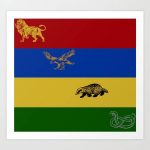 Animals
Animals
These bear close resemblance to the imagery found in the Bible’s book of Ezekiel, which has a peculiar entity with four faces resembing; a lion, an eagle, a man, and an ox.
Gryffindor = Lion. Atzilut is also the lion, reflecting passion and bravery that is based on the unity of being ‘one’ with the higher principles. In one sense, this is the opposite of Slytherin and the cause of the continued conflicts between members of those Houses. (See Slytherin below.)
Ravenclaw = Eagle. Beriah is also the eagle, which soars above ‘learning’ from the highest levels and gaining insight into making logical decisions. Beriah is the ‘uppermost’ of the three worlds making up ‘creation’ along with Yetzirah and Asiyah below it.
Slytherin = Serpent. Yetzirah is either the serpent or man. This is the most dynamic of the four as it relates to emotion and to the connective aspect of Jacob’s ladder, which itself is associate with the ‘ultimate man’ – the messiah. Note also the shape of the letter Vav in the 4-letter name (above) resembles a serpent.
Unchecked ambition may be a force of good or evil. It has the potential to lead or mislead others. (We explore this in our Matrix Knowledge Base, especially regarding the character of the Merovingian.)
A main point to the story is the reunification of what had been divided. Voldemort, of Slytherin, had as a goal a false unification as he desired to do away with the other Houses and force everyone to be of Slytherin. This is the result of ambition separated from higher principles.
Hufflepuff = Badger. Asiyah is an Ox, which like the badger walks on four legs and feeds close to the ground. The fourth world is associated with the ‘divine presence’ called the Shekinah, which exhibits patience awaiting the redemption and reacts violently when justice is perverted.
Elements
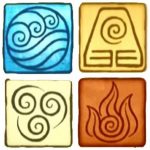 Kabbalistic texts associate certain elements with the four worlds. These align in the exact same manner with the four Hogwart’s houses in Harry Potter, according to author J.K. Rowling:
Kabbalistic texts associate certain elements with the four worlds. These align in the exact same manner with the four Hogwart’s houses in Harry Potter, according to author J.K. Rowling:
Gryffindor = Fire | Atzilut = Fire
Ravenclaw = Air | Beriah = Air
Slytherin = Water | Yetzirah = Water
Hufflepuff = Earth | Asiyah = Earth
This precise relationship and the rest we discuss, are shown together in a chart further down this page.
Colors
Each of the Houses has a crest made of two colors. In all four cases, one of the colors matches a corresponding kabbalistic color. There are some variances with the latter.
Below are the representative banners:



 Gryffindor = GOLD and red | Atzilut = Also GOLD
Gryffindor = GOLD and red | Atzilut = Also GOLD
Ravenclaw = BLUE and bronze | Beriah = Also BLUE
Slytherin = GREEN and silver | Yetzirah = GREEN (associated with Tiferet*) or purple (mix of red and blue)
Hufflepuff = BLACK and yellow | Asiyah = BLACK (the color that absorbs all above it) or red (color of the earth)
* Tiferet is the emanation that is said to ‘represent’ the group of six (masculine) emanations that are between (the feminine) emanations of Binah and Malkhut.
Regarding connections to the Harry Potter story, This lends to another interesting concept as the letter Vav (the 6th letter in the Hebrew alphabet by the way) and the six emanations connect the ‘earthly’ to the higher spiritual worlds. One could say it has a relationship to both worlds, or if you will, a ‘pure-blood’ connected to a ‘muggle’ in the story. Such a combination results in the most powerful entities, i.e. Harry, Voldemort and Snape – the latter being the “Half-blood Prince,” and hidden hero of the story.
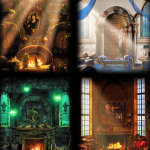 House Locations in Harry Potter
House Locations in Harry Potter
The physical locations of the House’s common rooms and/or dormitories also bear interesting connections to kabbalistic concepts:
Gryffindor = Their common room is in one of the castle’s highest towers, and its entrance is on the seventh floor in the east wing of the castle. In kabbalah, ‘east’ is “toward God” thus reflecting the world of Atzilut which we relate to Gryffindor.
Ravenclaw = Ravenclaw Tower is on the west side of Hogwarts. Harry stated (in book #7) that Ravenclaws, “have a spectacular view of the surrounding mountains,” which connects to their “eagle’s view” of things, mentioned earlier.
Slytherin = The Slytherin common room is a long, low room, under the lake. (Thus resembling a slithering serpent.) The room is described in the second book as having a greenish glow which relates to the House’s color scheme as mentioned above.
Hufflepuff = The Hufflepuff common room is near the kitchen – food being nourishment for the physical part of humans.
Who’s Where and Why in Harry Potter?
As mentioned, the House of Gryffindor has an overwhelmingly disproportionate number of ‘heroes’ in it. Its main characteristics of courage and passion are grounded in a mindset based on “higher principles.” (See our article on Stephen Covey’s 7 Habits.)
We examine a few of the main characters below.
Harry
When the Sorting Hat was deciding on which House to place Harry in, it greatly pondered three choices: Gryffindor, Ravenclaw and Slytherin:
“Difficult. Very difficult. Plenty of courage, I see. (Gryffindor) Not a bad mind, either. (Ravenclaw) There’s talent, oh my goodness, yes—and a nice thirst to prove yourself, (Slytherin) now that’s interesting… So where shall I put you?”
Harry hoped that he would not go into Slytherin, which showed he was not ruled by personal ambition. The hat could have also placed him in Ravenclaw, however, it saw that the attributes of courage and passion were greater in him. They would indeed be of the utmost importance in his task.
Hermione
Many people would guess the extremely intelligent and logical Hermione would be in the House of Ravenclaw. She certainly would have been a “perfect fit.” However, we find that Hermione valued bravery, a characteristic of Gryffindor, as more important.
As a young Hermione stated to Harry in book #1:
“Me!” said Hermione. “Books! And cleverness! There are more important things – friendship and bravery and – oh Harry – be careful!”
Neville
A third member of Gryffindor that we may find is surprising is Neville. He seems to be more of a Hufflepuff type as he is quite humble. He had doubts about his bravery at the time of the Sorting Hat, however as the series progressed, he was revealed to have enormous courage within him, multiple times risking his life for others and for the cause.
In one instance after voluntarily joining the Dumbledore’s Army members to go into battle with them, he makes his resolve clear to Harry:
Neville: “We were all in the D.A. together. It was all supposed to be about fighting You-Know-Who, wasn’t it? And this is the first chance we’ve had to do something real — or was that all just a game or something?”
Harry: “No … of course it wasn’t …”
Neville: “Then we should come too. We want to help.”
Summation
The other Gryffindor members also exhibited the characteristics of courage and passion through the story, all the more so as the situation became seemingly dire for them.
Nonetheless, all Houses contributed to the final rectification, which, by the way, shares a great deal in common with other movie stories such as The Matrix, Star Wars and Lion King with regard to the reunification of a reality that had been fractured.
The chart below offers a view of the connections between the kabbalistic concepts and the Hogwart’s Houses.
